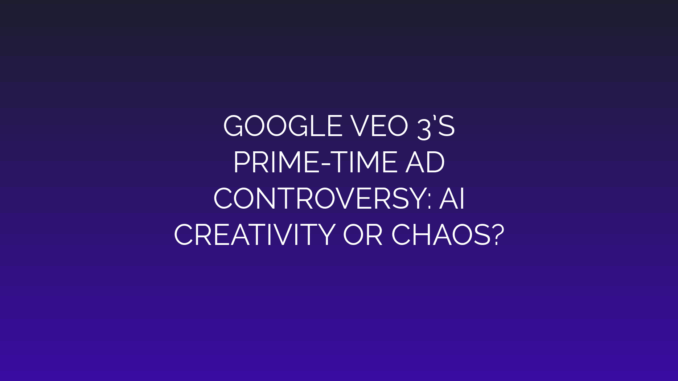
Google Veo 3’s Prime-Time Ad Controversy: AI Creativity or Chaos?
In a world increasingly shaped by generative artificial intelligence, Google’s unveiling of its revolutionary texttovideo model, Veo 3, promised to redefine creative boundaries. However, its highstakes debut during a primetime advertising slot ignited a firestorm—not of awe, but of fierce debate. The ad showcased Veo 3’s ability to craft hyperrealistic video scenes from minimal text prompts. Yet critics decried it as a reckless display of AI ethics run amok, while proponents hailed it as a milestone in creative innovation. This clash exemplifies a pivotal question: Is Veo 3 pioneering the future of storytelling, or unraveling trust in media itself?
What Is Google Veo 3? Google Veo 3 represents a quantum leap in texttovideo generation, building on its predecessors with unprecedented fidelity. Designed to interpret complex prompts—like “a rainy Tokyo street at dusk with holographic koi swimming through neon signs”—it produces smooth, coherent 60second clips rivaling studio production quality. The technology uses advanced diffusion models and multimodal training, analyzing billions of videotext pairs to simulate lighting, motion, and even abstract concepts. Unlike basic AI tools, Veo 3 promises cinematiclevel outputs while integrating seamlessly with existing workflows. Its launch positioned Google as a disruptor in advertising, entertainment, and even usergenerated content.
The PrimeTime Ad That Sparked Outrage On June 12, during a nationally televised sports event, Google aired a 90second commercial exclusively showcasing Veo 3. The ad featured rapidly shifting scenes—from a melting ice castle to warriors dueling atop floating asteroids—all described as “100% AIgenerated, zero human edits.” While visually spectacular, it omitted disclosures about limitations, safeguards, or potential misuses. This omission proved explosive. Within minutes, social media erupted with accusations. Critics noted scenes subtly manipulating historical footage, such as a reimagined moon landing with anomalous details. Worse, an uncanny sequence mimicked the likeness of a recently deceased celebrity, seemingly without consent. The tagline—“Unleash imagination. No rules, no limits.”—became a lightning rod.
The Backlash: Accusations of Reckless Chaos The fallout was swift and multifaceted. Media ethicists, content creators, and policymakers condemned the ad as irresponsible deployment of technology. Key criticisms included:
- Misinformation risks: The premature normalization of undetectable synthetic media, potentially accelerating deepfakes and political disinformation.
- Economic disruption: Fears of job losses in animation, advertising, and filmmaking, with trade unions warning of “automated creative displacement.”
- Ethical negligence: Flouting emerging AI transparency norms by failing to watermark content or disclose generative sources.
- Artistic exploitation: Using likenesses without legal frameworks for digital consent or compensation.
YouTube creators reported a surge in AIgenerated impersonator channels, citing Veo 3’s ad as validation. UNESCO issued a statement calling for urgent regulatory safeguards to avoid “cultural chaos.”
The Defense: Celebrating Unprecedented Creativity Google and its supporters countered that critics underestimated Veo 3’s positive transformation of creative industries. Key arguments emerged:
- Democratizing creativity: Enabling small businesses and solo creators to produce high-impact visuals without million-dollar budgets.
- Iterative evolution: Framing the ad as aspirational, with ongoing refinements to address risks (e.g., Veo 3 now uses metadata tagging in tests).
- Potential to boost storytelling: Generative tools empower novel narratives, like personalizing educational content or reviving historical events.
Filmmakers like Ava DuVernay endorsed “experimental phases” in AI, while brands like Airbnb tested Veo 3 for dynamic travel ads. Sundance Festival even announced entries in its 2025 lab accepting AIgenerated shorts. Jason Teague, Google’s VP of Creative Innovation, defended the campaign: “Revolution doesn’t ask permission. Our priority is guiding it responsibly.”
Ethical Considerations and Industry Crossroads The Veo 3 controversy now forces urgent conversations about AI governance: 1. Regulatory gaps: With the EU AI Act yet to cover dynamic models, U.S. proposals stalled, and deepfake laws fragmented, companies set their own boundaries. 2. Attribution standards: Pressure mounts for C2PAcompliant watermarking and mandatory disclosures. 3. Guardrails vs. innovation: Can fair AI ethics coexist with rapid experimentation?
For artists, consent frameworks like “optin IP vaults” gain traction. Technologists, meanwhile, urge multistakeholder crisis simulations to anticipate misuse scenarios.
Conclusion: Navigating the Edge of Possibility Google Veo 3’s primetime controversy is not a blunder—it’s a critical stress test. Its spectacle exposed vulnerabilities in media trust and governance, but also the transformative power of AIdriven creativity. In this nascent era, neither unregulated freedom nor reactionary constraints foster progress. The solution lies in balanced, adaptive ethical innovation:
- For creators: Develop clear licensing models and attribution tools to protect rights.
- For platforms: Enforce transparency and invest in detectability R&D.
- For policymakers: Prioritize flexible, risk-based regulations.
Veo 3 has irrevocably accelerated the AIvideo revolution. Its legacy? How humanity decides to steer it.
Implications at a Glance
- Industry Pushback with SD Proactive Moves: Adobe added Veo 3 exports to Content Credentials.
- Emerging Deeper: UNESCO initiatives with African regulators.
- User Rights: YouTube plans a “Synthetic Media” label by September.
- Nearer Threat: Wavers chain faster designed Google’s temporary mitigation.
As Veo 3 evolves, transparency—not just proficiency—must define generative AI’s golden standard. Without accountability, chaos looms; with it, creativity’s frontier expands. Is your organization ready?
Leave a Reply